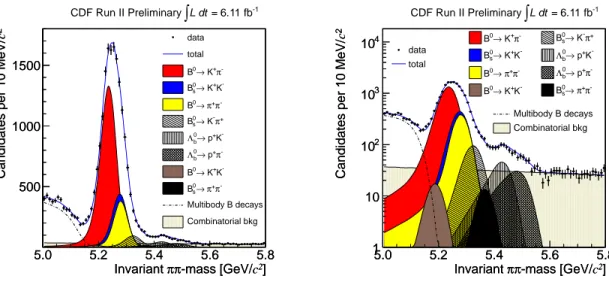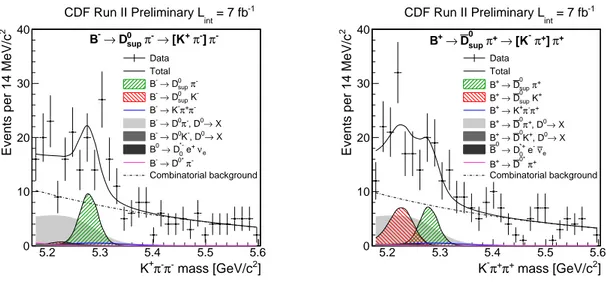arXiv:1201.5267v1 [hep-ex] 25 Jan 2012
CDF
Michael J. Morello∗†
Scuola Normale Superiore di Pisa and INFN Sezione di Pisa E-mail:[email protected]
The CDF experiment at the Tevatron p ¯p collider established that extensive and detailed
explo-ration of the b–quark dynamics is possible in hadron collisions, with results competitive and
supplementary to those from e+e−colliders. This provides a rich, and highly rewarding
pro-gram that has currently reached full maturity. In the following I report some recent results on hadronic decays: the evidence for the charmless annihilation decay mode B0s →π+π−, and the
first reconstruction in hadron collisions of the suppressed decays B−→ D(→ K+π−)K− and
B−→ D(→ K+π−)π−.
The 2011 Europhysics Conference on High Energy Physics, EPS-HEP 2011, July 21-27, 2011
Grenoble, Rhône-Alpes, France
∗Speaker.
1. Evidence for the charmless annihilation decay mode B0s →
π
+π
−Two-body non-leptonic charmless decays of b–hadrons are very widely studied processes in flavor physics. The variety of open channels involving similar final states provides useful exper-imental information to improve the accuracy of effective models of strong interaction dynamics. Some decays receive contributions from higher-order (‘penguin’) transitions, and are therefore sen-sitive to the possible presence of new physics in internal loops.
The B0s →π+π− and B0→ K+K− decay modes have a special status, in that all quarks in the final state are different from those in the initial state. This limits the possible diagrams that can contribute to these decay to penguin-annihilation (PA) and W -exchange (E) topologies. They have never been observed, and the best upper limits come from [1, 2]. These amplitudes are difficult to predict within the current phenomenological models, and are often neglected in calculations of de-cays where they are not the only contributors, using generic argument of smallness. These diagrams may carry different CP-violating and CP-conserving phases with respect to leading diagrams; the lack of knowledge of their size therefore introduces unavoidable uncertainties in the conclusions drawn from the analyses of other well-studied decays, like B0→π+π− and B0s → K+K−. A mea-surement of branching fraction of both B0s→π+π−and B0
→ K+K−would be particularly useful, as it allow a better determination of the strength of PA and E amplitudes.
] 2 c [GeV/ -mass π π Invariant 5.0 5.2 5.4 5.6 5.8 2 c
Candidates per 10 MeV/
500 1000 1500 ] 2 c [GeV/ -mass π π Invariant 5.0 5.2 5.4 5.6 5.8 2 c
Candidates per 10 MeV/
500 1000 1500 -1 = 6.11 fb L dt ∫ CDF Run II Preliminary data total -π + K → 0 B -K + K → 0 s B -π + π → 0 B + π K → 0 s B -K + p → 0 b Λ -π + p → 0 b Λ -K + K → 0 B -π + π → 0 s B Multibody B decays Combinatorial bkg ] 2 c [GeV/ -mass π π Invariant 5.0 5.2 5.4 5.6 5.8 2 c
Candidates per 10 MeV/
1 10 2 10 3 10 4 10 B0→ K+π -K + K → 0 s B -π + π → 0 B -K + K → 0 B + π K → 0 s B -K + p → 0 b Λ -π + p → 0 b Λ -π + π → 0 s B Multibody B decays Combinatorial bkg data total ] 2 c [GeV/ -mass π π Invariant 5.0 5.2 5.4 5.6 5.8 2 c
Candidates per 10 MeV/
1 10 2 10 3 10 4 10 -1 = 6.11 fb L dt ∫ CDF Run II Preliminary
Figure 1: Invariant mass distribution of reconstructed B0(s)→ h+h′−candidates (linear scale on the left and
logarithmic scale on the right). The charged pion mass is assigned to both tracks. The sum of the fitted distributions and the individual components of signal and background are overlaid on the data distribution.
CDF recently searched for both B0s→π+π−and B0→ K+K−, using a data sample of 6fb−1of integrated luminosity. An extended unbinned likelihood fit, incorporating kinematic (invariant mass and momenta) and particle identification (dE/dx) information, is used to determine the fraction of each individual B0(s)→ h+h′−(where h is for a pion or kaon) mode in the sample. The fit projection on the invariant ππ-mass is reported in fig. 1. A 3.7σ significant signal is observed for the B0s → π+π−mode, while a deviation at the 2σ level from no signal hypothesis is reported for the B0→
K+K−. The measured branching ratios are B(B0
B(B0→ K+K−) = (0.23±0.10±0.10)×10−6 [3]. A 90% confidence interval for the B0→ K+K− mode is also reported[0.05, 0.46] × 10−6 [3]. The result for the B0
s →π+π− mode is consistent
with the previous upper limit (< 1.2 × 10−6 at 90% C.L.), based on a subsample of the current data [2] and it is in agreement with the very recent result from LHCb [4]. This agrees with the predictions in Ref. [5] within the pQCD approach. It is higher than most other predictions [6, 7, 8]. The present measurement of B(B0→ K+K−) supersedes the previous limit [2]. The central value is in agreement with other existing measurements [9, 1, 4], and with theoretical predictions [6, 8]. 2.
γ
from B → DK decaysConventionally, CP violating observables are written in terms of the anglesα,β andγ of the “Unitarity Triangle", obtained from one of the unitarity conditions of the CKM matrix. While the resolution onα and β reached a good level of precision, the measurement ofγ is still limited by the smallness of the branching ratios involved in the processes. Among the various methods for theγmeasurement, those which make use of the tree-level B−→ D0K− decays have the smallest theoretical uncertainties. In factγ appears as the relative weak phase between two amplitudes, the favored b → c ¯us transition of the B−→ D0K−, whose amplitude is proportional to VcbVus, and the
color-suppressed b → u ¯cs transition of the B−→ D0K−, whose amplitude is proportional to VubVcs.
The interference between D0 and D0, decaying into the same final state, leads to measurable CP-violating effects, from whichγ can be extracted. The effects can be also enhanced choosing the interfering amplitudes of the same order of magnitude. All methods require no tagging or time-dependent measurements, and many of them only involve charged particles in the final state.
] 2 mass [GeV/c -π -π + K 5.2 5.3 5.4 5.5 5.6 2
Events per 14 MeV/c
0 10 20 30 40 -π ] -π + [K → -π sup 0 D → -B Data Total -π 0 sup D → -B K 0 sup D → -B -π + π K → -B X → 0 , D -π 0 D → -B X → 0 , D -K 0 D → -B e ν + e 0 D → 0 B -π 0* D → -B Combinatorial background -1 = 7 fb int CDF Run II Preliminary L ] 2 mass [GeV/c + π + π -K 5.2 5.3 5.4 5.5 5.6 2
Events per 14 MeV/c
0 10 20 30 40 + π ] + π [K → + π sup 0 D → + B Data Total + π 0 sup D → + B + K 0 sup D → + B + π -π + K → + B X → 0 , D + π 0 D → + B X → 0 , D + K 0 D → + B e ν e 0 *+ D → 0 B + π 0* D → + B Combinatorial background -1 = 7 fb int CDF Run II Preliminary L
Figure 2: Invariant mass distributions of B±→ Dh±for the suppressed mode (bottom meson on the left and antibottom on the right). The pion mass is assigned to the charged track from the B candidate decay vertex. The projections of the likelihood fit are overlaid.
In a data sample of about 7 fb−1 CDF reports the first reconstruction in hadron collisions of the suppressed decays B−→ D(→ K+π−)K− and B−→ D(→ K+π−)π−, which are the main ingredient of the the ADS method [10]. Also in this case an extended unbinned likelihood fit,
incorporating kinematic (invariant mass) and particle identification (dE/dx) information, is used to determine the fraction of each individual modes. The fit projection on the invariant Kππ-mass is reported in fig. 2. CDF measures the following asymmetries: AADS(K) = −0.82 ± 0.44(stat) ±
0.09(syst) and AADS(π) = 0.13 ± 0.25(stat) ± 0.02(syst) [11], and for the ratios of doubly Cabibbo
suppressed mode to flavor eigenstate CDF finds RADS(K) = [22.0 ± 8.6(stat) ± 2.6(syst)] × 10−3
and RADS(π) = [2.8 ± 0.7(stat) ± 0.4(syst)] × 10−3 [11]. The results are in agreement with existing
measurements performed atϒ(4S) resonance [12] and very recently at LHCb [13]. 3. Conclusions
CDF experiment at the Tevatron keeps providing excellent results in the exploration of Heavy Flavor Physics, owing to CP-symmetric initial states in√s= 1.96 TeV p ¯p collisions, large event samples collected by well-understood detector, and mature analysis techniques. In summary, this short write-up reports on the first evidence for the charmless annihilation decay mode B0s→π+π−, an updated upper limit for the B0→ K+K− mode, and on the first reconstruction in hadron colli-sions of the suppressed decays B−→ D(→ K+π−)K−and B−→ D(→ K+π−)π−.
References
[1] K. Abe et al. (Belle Collaboration), Observation of B Decays to Two Kaons, Phys. Rev. Lett. 98,
181804 (2007) [hep-ex/0608049].
[2] T. Aaltonen et al. (CDF Collaboration), Observation of New Charmless Decays of Bottom Hadron,
Phys. Rev. Lett. 103, 031801 (2009) [hep-ex/0812.4271].
[3] T. Aaltonen et al. (CDF Collaboration), Evidence for the charmless annihilation decay mode
B0s →π+π−,hep-ex/1111.0485, submitted to Phys. Rev. Lett.
[4] LHCb Collaboration, Charmless charged two-body decays at LHCb with 2011 data, LHCb-CONF-2011-042; A. Carbone, these proceedings.
[5] A. Ali et al., Charmless nonleptonic Bsdecays to PP, PV, and VV final states in the perturbative QCD approach, Phys. Rev. D 76, 074018 (2007) [hep-ph/0703162]; Y. Li et al., Branching ratio and
CP asymmetry of B0s→π+π−decays in the perturbative QCD approach, Phys. Rev. D 70, 034009
(2004) [hep-ph/0404028].
[6] M. Beneke and M. Neubert, QCD factorization for B → PP and B → PV decays, Nucl. Phys. B675,
333 (2003) [hep-ph/0308039].
[7] J.-F. Sun, G.-H. Zhu, and D.-S. Du, Phenomenological Analysis of Charmless Decays Bs→ PP,PV
with QCD Factorization, Phys. Rev. D 68, 054003 (2003) [hep-ph/0211154].
[8] H.-Y. Cheng and C.-K. Chua, QCD Factorization for Charmless Hadronic BsDecays Revisited, Phys.
Rev. D 80, 114026 (2009) [hep-ph/0910.5237]; Revisiting charmless hadronic Bu,ddecays in
QCD factorization, Phys. Rev. D 80, 114008 (2009) [hep-ph/0909.5229].
[9] B. Aubert et al. (BABARCollaboration), Improved Measurements of the Branching Fractions for
B0→π+π−and B0→ K+π−, and a Search fro B0→ K+K−, Phys. Rev. D 75, 012008 (2007) [hep-ex/0608003].
[10] D. Atwood, I. Dunietz and A. Soni, Enhanced CP Violation with B → KD0( ¯D0) Modes and
[11] T. Aaltonen et al. (CDF Collaboration), Measurements of branching fraction ratios and
CP-asymmetries in suppressed B−→ D(→ K+π−)K−and B−→ D(→ K+π−)π−decays, Phys. Rev.
D 84, 091504 (2011) [hep-ex/1108.5765].
[12] Y. Horii et al. (Belle Collaboration), Evidence for the Suppressed Decay B−→ DK−, D → K+π−,
Phys. Rev. Lett. 106, 231803, (2011) [hep-ex/1103.5951]; P. del Amo Sanchez et al. (BABAR
Collaboration), Search for b → u transitions in B−→ DK−and B−→ D∗K−Decays, Phys. Rev. D
82, 072006, (2010) [hep-ex/1006.4241].
[13] LHCb Collaboration, Evidence for the suppressed decay B±→ (K∓π±)DK±,

